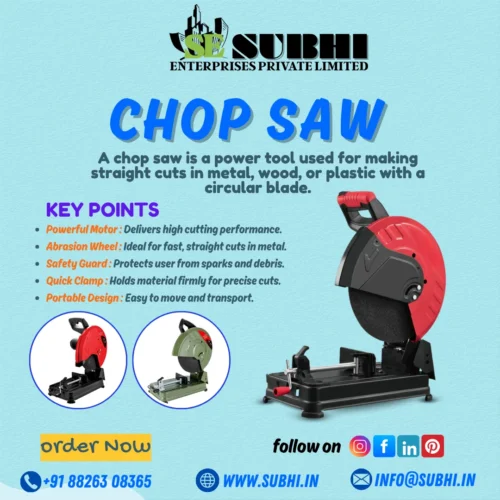Among the most powerful cutting tools you can think of is the chop saw. Great for professional workshops and construction sites, as well as for the most dedicated DIYers, chop saws are rugged, reliable, and they cut through several materials with ease.
So, what is a chop saw? How is it differentiated from other saws? More importantly, what factors do you need to consider when choosing a chop saw? Whether you’re looking to enhance your current setup or you’re completely new to power tools, this guide will equip you with all the necessary information you need.
What is a Chop Saw?
A stationary saw that cuts using a rotating blade is a basic definition of a chop saw. You place your material on the saw and chop with it at an upward angle to cut through – thus the term.
Chop saws are efficient at making fast and clean cuts on wood, PVC, metal, and a number of other hard materials. They are known for their straight and 90degree cuts. Unlike portable hand-held saws, which at times can compromise precision, accuracy, and stability, these saws are mounted on a workbench or on a stand, offering those additional features.
The two most common variants of chop saws are:
Metal Chop Saws : These are specifically made for cutting metals which include but are not limited to: steel, aluminum, and even rebar.
Wood Chop Saws : These may be called miter saws but unlike miter saws, are fitted with pivoting arms for angled cuts.
For now, we will look at the metal chop saw but with the exception of one or two details, everything else is cross applicable.
Anatomy of a Chop Saw
Before we get too deep into it, let’s first identify the basic parts of a chop saw:
Blade : The star of the show. Metal chop saws typically use an abrasive disc or a carbide tipped blade.
Motor : Typical range for consumer models is usually 13 – 15 amps but heavy duty versions may be much stronger.
Fence : A back support that helps to position the material correctly for a straight cut.
Vise or Clamp : Prevents the material from shifting during the cut by holding it in place.
Trigger and Handle : The parts used to manage the blades’s descend.
Base : This is the sole platform that holds and supports all of the said components.
Every single part undergoes customization and merging to reduce the tool’s speed, power, and safest settings.

Why Use a Chop Saw?
There are a few big reasons why chop saws are so popular:
1. Speed
Using a hacksaw to cut a steel pipe is perhaps one of the most infuriating activities you can engage in. A chop saw can slice through it in mere seconds. Saving time on a job site results in money saved and a chop saw is the ultimate tool for achieving this goal.
2. Precision
Perfectly aligned and repeated cuts can be made thanks to the adjustable fence and fixed base. In industries where even minor errors can result in huge problems, this functionality becomes vital.
3. Versatility
Some models of chop saws are specially designed to cut plastics, masonry, and even wood in addition to metals.
4. Durability
Designed for heavy duty repetitive cutting, chop saws retain their power and accuracy even after extensive use.
Key Features to Look for in a Chop Saw
Before making a purchase, consider these important features:
1. Blade Size
Commonly used with a 14 inch blade, some models of chop saws have 15 to 16 inch blades. The larger the blade, the deeper the cut.
2. Motor Power
For a motor’s rating, the amp range increases with the amount of tough materials a motor can interface with, with 15 amps usually being ideal for general use motors.
3. Blade Type
Abrasive wheels, while able to cut fast, do wear out over time.
Unsurprisingly, carbide tipped blades are more expensive, but they stay sharper for longer and cut cleaner.
4. Adjustable Fence
Fences that can pivot are ideal, as they configure angled cuts, usually of 45 degrees, if need be.
5. Spark Deflector
Cutting metal generates showers of sparks, and a good spark deflector will help control the direction of the spark for better operation.
6. Portability
Some light-weight saws and those with carrying handles are easier to move around, and thus more portable between work sites.
7. Build Quality
Accurate cuts from saws are largely dependent on sturdy bases used to build them. Bases made of steel or cast aluminum add stability and reduce vibrations.

Chop saws have a multitude of applications spanning various industries. Common examples include:
Metal Fabrication : Sheets of metal, pipes and beams can be cut easily.
Construction : Rebar, metal studs and fencing are simple to prepare.
Diy Projects : Makes it easy to design furniture or repair fences.
Automotive : Fitting exhaust roll cages and trimming chassis parts.
Plumbing : Works well for cutting large diameter pipes made of PVC or metal.
If your line of work deals with hard materials, a chop saw would be a perfect match for you.
How to Safely Use a Chop Saw
Any tool that can shred steel like it is butter should always be approached with caution. Here are some basic safety tips:
(i). Wear appropriate protective equipment
(ii). Always wear safety glasses, ear defenders, and gloves. Sparks tend to fly all over and the saw is extremely loud.
(iii). Make sure your materials are secure.
(iv). Always use the built in vise or a strong clamp to hold the workpiece securely. Loose materials can move with undue force.Stand to the Side
(v). Position yourself off-center of the blade – not directly behind it. That way, if something goes awry, you will stay out of the line of fire.
Maintain the Blade
(i). Every blade needs an inspection and a replacement from time to time…a dull, damaged blade, however, becomes a hazard.
(ii). Keep the Area Clear
(iii). To prevent discrepancies with tripping or interference, clear unnecessary tools, debris, or clutter from your workspace.
Common Mistakes to Avoid
Even seasoned pros slip up sometimes. Here are a few common blunders:
(i). Forcing the Cut : The saw has its own blades of grass to cut and will do so on its own if you don’t overexert force. Shoving the blade down will cause binding, overheating, or even shattering the blade.
(ii). Ignoring the Spark Path : Make sure to check where the sparks are aimed at…make sure neither flammable materials, such as your jeans, a pile of wood shavings, or a nearby fuel can, are in the vicinity.
(iii). Wrong Blade for the Material : Can easily injure you while destroying both your blade and material.
(iv). Regular Peripheral Maintenance : Saw cleaning, motor brush examination, and checking the operating cord for damage should be done periodically.
The Leading Manufacturers of Chop Saws
Final Thoughts: Are chopping saws worth investing in?
Investment in a chop saw is appealing for anyone who regularly deals with longitudinal cuts on coarse materials because the saw guarantees accuracy and speed.
It cannot be ignored that a chop saw’s use will save a considerable amount of both time and energy as the tool makes precision cuts which hand tools or other lower grade saws cannot achieve.
A quality chop saw will rapidly become indispensable for fabricators, builders, mechanics, or even aspiring DIY enthusiasts.
Chop saws, like any serious machinery, require careful consideration ahead of purchase. One should always consider motor power, blade type, and other relevant features that a manufacturer offers before making a purchase. Furthermore, one should also ensure that the chop saw is well-maintained, which can easily lead to a decade’s worth of utility from the machine.
